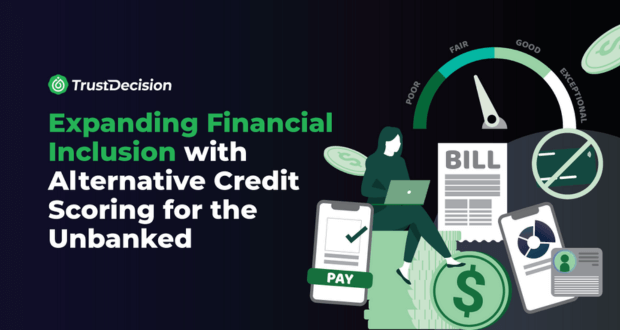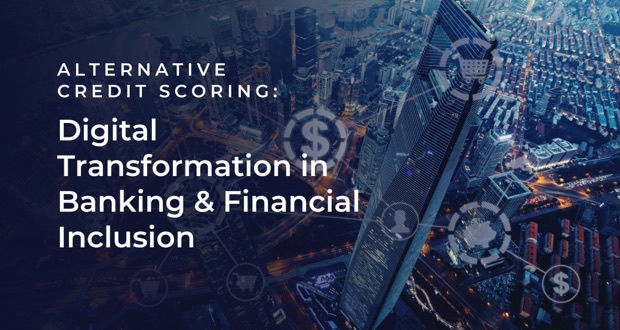Key Takeaways
- Alternative data sources (telecom, utilities, e-commerce) enable credit scoring for previously unscored populations
- ML-driven models outperform rule-based systems with superior default prediction accuracy
- Financial inclusion expands as thin-file consumers gain access to formal credit services
- Economic impact could add $290 billion to Southeast Asian GDP by 2030
- Bias management requires transparent governance and ethical AI frameworks
- Technology enablers include cloud scoring engines, open banking APIs, and fraud detection systems
Introduction: Why Alternative Credit Scoring Matters for Financial Inclusion
Alternative credit scoring uses non-traditional data sources—telecommunications usage, utility payments, e-commerce behaviors—to assess creditworthiness beyond conventional bureau scores. This approach addresses the 1.7 billion adults globally who remain unbanked, according to the World Economic Forum.
McKinsey research demonstrates that expanded credit access through alternative data could add $3.7 trillion to emerging market GDP by 2030. This positions alternative data integration as critical infrastructure for financial inclusion and economic development.
What Is Alternative Credit Scoring?
Alternative credit scoring integrates non-traditional data sources into lending and risk models to assess creditworthiness beyond conventional bureau scores. This comprehensive approach enables lenders to serve thin-file borrowers while maintaining robust risk management through diversified data enrichment strategies.
Core Alternative Credit Scoring Models:
- Telecommunications Data Integration analyzes mobile phone usage patterns, including top-up frequencies, call consistency, and account tenure. Regular mobile payment behavior and consistent account management often indicate financial discipline and repayment reliability, making telecommunications data a valuable alternative credit signal.
- Utility Payment Analysis tracks electricity, water, and internet bill payment histories to establish creditworthiness baselines. Consistent utility payments often indicate financial discipline and cash flow stability, making them reliable predictors for small-value lending decisions.
- E-commerce Behavioral Signals examine purchase patterns, return rates, and Buy-Now-Pay-Later (BNPL) repayment performance. These signals reveal spending habits and payment discipline across digital commerce platforms, providing insights into consumer financial behavior.
- Device Metadata and Digital Footprints incorporate geolocation consistency, mobile application usage patterns, and device registration data. While requiring careful privacy consideration, these signals can indicate borrower stability and identity verification for credit risk modeling.
Which Alternative Data Sources Improve Prediction for Thin-File Consumers?
Research identifies specific data categories that demonstrate superior predictive value for creditworthiness assessment among previously unscored populations.
Payment History Beyond Credit Bureaus
Represents the strongest predictor for thin-file consumers. The Urban Institute's research shows that adding rental data via tools like VantageScore increased the share of people with credit files by 12 percentage points, with particularly notable improvements for renters previously outside mainstream scoring systems. Utility payment consistency shows similar predictive strength, with telecommunications bill payments providing particularly reliable signals in emerging markets.
Cash Flow Analysis from Banking APIs
Provides real-time evaluation of income and expense patterns. According to the Bank for International Settlements (BIS) 2024 report, integrating cash-flow analytics enhances the accuracy of credit risk models and expands access to finance for underserved consumers.
Behavioral Consistency Signals
Reveal stability across multiple touchpoints. Research on micro-lending credit risk models demonstrates that incorporating behavioral stability metrics—such as transaction regularity and engagement consistency—improves predictive accuracy. Studies confirm that call-detail records and social network behaviors further strengthen scoring models, delivering higher accuracy and expanding credit access for thin-file borrowers.
The AFI 2025 report on alternative data for credit scoring confirms that digital lenders in emerging markets are adopting these data sources to responsibly expand credit access while maintaining sound portfolio performance.
How Do ML-Driven Models Compare to Rule-Based Alternative Scores?
Machine learning approaches fundamentally outperform traditional rule-based systems in alternative credit scoring applications, particularly when processing diverse, non-traditional data sources.
- Rule-Based Model Limitations become apparent when handling alternative data complexity. Static threshold systems often struggle with heterogeneity in data sources like telco, utility, or open banking inputs, and require frequent manual rule updates to keep pace with evolving consumer behaviors.
- Machine Learning Model Advantages include continuous learning capabilities, pattern recognition across multiple data dimensions, and adaptive threshold optimization. ML models automatically adjust to changing borrower behaviors and economic conditions without manual intervention.
McKinsey's research on digital transformation in lending across Southeast Asia underscores how ML-driven models, when combined with digital data sources, can accelerate approval processes, improve risk-adjusted outcomes, and significantly enhance efficiency compared to traditional rule-based systems.
What Bias Risks Arise from Using Social and Behavioral Data?
Alternative credit scoring introduces significant ethical considerations requiring proactive management to ensure fair and inclusive lending practices.
Key Risk Areas:
- Algorithmic bias when social and behavioral data reinforce existing inequalities
- Social group discrimination through location-based or network analysis scoring
- Regulatory compliance challenges with GDPR's "right to explanation" and emerging AI governance frameworks
Understanding how to effectively manage these bias risks from social and behavioral data requires implementing comprehensive governance frameworks that balance innovation with ethical responsibility.
Best Practice Implementation:
- Fairness Auditing: Regular bias testing across demographic groups
- Transparent Decision Frameworks: Explainable AI implementation for credit decisioning transparency
- Ethical AI Governance: Cross-functional teams ensuring responsible data usage
- Consumer Protection Standards: Clear opt-out mechanisms and data usage disclosure
The Economic Impact of Alternative Credit Scoring
Alternative credit scoring creates measurable economic impacts through expanded credit access across previously underserved market segments.
Credit Access Expansion enables SMEs to gain working capital, rural households to access micro-loans for agriculture and education, and young consumers to build credit footprints through e-commerce and digital payment behaviors.
Bain & Company's research on Southeast Asia's digital financial ecosystem highlights the transformative potential of alternative data and ML-driven credit solutions to drive economic growth and unlock SME financing opportunities. Countries implementing comprehensive alternative credit frameworks show 40% faster economic recovery following external shocks, according to the International Monetary Fund's 2024 financial stability report.
Shadow Lending Reduction occurs as formal financial institutions serve previously excluded populations. Alternative scoring enables regulated lenders to compete effectively with informal credit providers, improving consumer protection and financial system oversight.
Real-World Success Stories in Banking and Fintech
Real-world implementations demonstrate alternative credit scoring effectiveness across diverse market contexts and institutional types.
1. Indonesian Retail Banking Success
Bank Jago (Indonesia) has emerged as one of Indonesia's leading digital-first banks, serving more than 10 million customers. By integrating with platforms such as Gojek and leveraging data-driven onboarding, Bank Jago extends credit responsibly to underserved populations while keeping non-performing loans below 0.3%—well under the industry average.
2. African/Asian SME Digital Lending
Tala (Africa & Asia) operates across Kenya, the Philippines, Mexico, and India, using mobile phone metadata and transaction patterns to score borrowers who lack formal credit histories. The Accounting Review found that Tala's approach measurably improved borrower outcomes, with average household income rising 20.8% and employment increasing by 23.5% for participants compared to control groups.
3. China Insurance Underwriting Innovation
Ping An (China), one of the world’s largest insurers, has pioneered AI-driven underwriting, processing 93% of new policies within seconds. With over 220 million customers, Ping An applies machine learning and health ecosystem data to personalize insurance products and improve operational efficiency.
However, data integrity remains crucial. Robust loan application fraud detection ensures alternative data reliability and prevents gaming of scoring systems.
Technology Infrastructure Enabling Scale
Advanced technology infrastructure enables scalable alternative credit scoring implementation across financial institutions of varying sizes and sophistication levels.
Core Technology Components:
- Fraud Detection and KYC Integration ensures alternative data reliability through comprehensive validation frameworks. Modern systems verify data source authenticity, detect synthetic identity fraud, and validate alternative data integrity before incorporation into credit models.
- Cloud-Based Scoring Engines provide scalable processing power for complex alternative data analysis with API-first architectures, enabling seamless integration with existing banking infrastructure and third-party data providers.
- Open Banking API Integration facilitates secure, regulated access to consumer financial data across multiple institutions. This standardized approach enables comprehensive cash flow analysis, account behavior assessment, and income verification through authorized data sharing frameworks.
- Generative AI Applications enhance credit risk analysis through advanced pattern recognition and predictive modeling. Gartner's 2025 AI report projects that 60% of financial institutions will incorporate generative AI into credit decisioning processes by 2027, improving both accuracy and explainability of alternative scoring models.
Source: Jasleen Kaur Sindhu, et.al. January 2025, Market Guide for Generative AI Services for Banking.
Strategic Technology Links:
- Credit Risk Management Platform for comprehensive alternative data integration
- Identity Verification Solutions for enhanced KYC and fraud prevention
- Digital Bank & Lending Solutions for scalable consumer lending platforms
These technological foundations enable financial institutions to implement alternative credit scoring effectively while maintaining security, compliance, and operational efficiency standards.
Strategic Implementation Considerations
Successful alternative credit scoring requires comprehensive planning addressing regulatory, operational, and strategic considerations.
- Regulatory Alignment demands careful attention to Basel III capital requirements, local credit bureau regulations, and consumer protection standards. Financial institutions must ensure alternative scoring models meet regulatory validation requirements while maintaining compliance with fair lending practices and privacy regulations.
- Model Validation and Monitoring establishes ongoing performance oversight through comprehensive testing frameworks, including backtesting against traditional models, stress testing across economic scenarios, and continuous monitoring for bias and performance degradation.
- Strategic Partnership Development enables access to high-quality alternative data sources through partnerships with telecommunications providers, utility companies, e-commerce platforms, and fintech data aggregators.
- Risk Management Framework Enhancement adapts existing credit risk governance to incorporate alternative data considerations, including updating risk appetite statements and training risk management teams on alternative scoring methodologies.
These strategic foundations enable financial institutions to realize alternative credit scoring benefits while maintaining operational excellence and regulatory compliance standards.
Conclusion: Building Inclusive Financial Systems
Alternative credit scoring represents a fundamental shift toward inclusive financial systems that recognize financial responsibility regardless of traditional credit history. With over 1.7 billion adults globally lacking traditional credit access, institutions that master alternative data integration will capture significant growth opportunities while contributing to economic development.
Success requires balanced implementation prioritizing robust governance, ethical AI principles, and regulatory compliance alongside commercial objectives. Financial institutions embracing these principles will drive meaningful financial inclusion while building sustainable competitive advantages in rapidly evolving markets.





%2520(1).png)







